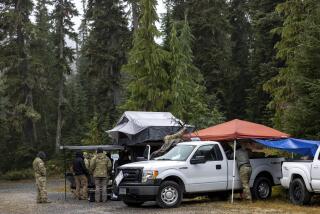Tustin Marine Crew of 4 Dead in Pendleton Helicopter Crash
- Share via
The bodies of four Tustin Marines were removed Friday from the wreckage of a helicopter that crashed and burned Thursday during a nighttime training mission in a remote area of Camp Pendleton.
It was the second fatal accident involving the CH-46E Sea Knight Marine helicopter in less than seven months. A February crash just east of the El Toro Marine Corps Air Station killed three Marine reservists.
The Thursday crash occurred at 9 p.m. in a remote corner of the base during what a Marine spokesman described as very hazy conditions. The site was about six miles northwest of Fallbrook and 10 miles east of Interstate 5. The helicopter, according to the military, apparently crashed into the hills surrounding a flat mesa about 2,000 feet above sea level.
Spokesman said a small brush fire was spotted shortly after the crash.
Maj. H.C. Polacke, a Marine spokesman, said it appeared the helicopter was flying beneath a blanket of clouds and was using visual flight rules when it crashed. A companion copter apparently reported the accident.
Polacke said investigators would remain at the accident site Friday night.
Victims Identified
The victims were identified as:
- 1st Lt. Chris Robin Toburen, 27, the pilot, who lived in Laguna Hills with his wife, Judy. He formerly lived in Pittsburg, Kan.
- 1st Lt. Scott R. Hiester, 27, the co-pilot, of Mission Viejo. He is survived by his wife and came from Robesonia, Pa.
- 1st Lt. Christopher A. Tanner, 27, of El Toro, formerly of Malvern, Ark.
- Lance Cpl. Todd B. Kershner, 20, of Lomax, Ill.
“The helicopter was participating in routine night training at the time of the mishap,” Marine spokesman Maj. Tom Mitchell said. He said the copter belonged to the Marine Medium Helicopter Squadron 164, Group 16, 3rd Air Wing at the Tustin Marine Corps Air Station.
Mitchell said the helicopter had taken off from Tustin and was scheduled to return to the air station. About 70 of the Sea Knights are stationed at Tustin.
Built by the Philadelphia-based Boeing Vertol Co., the CH-46 Sea Knight has been involved in 186 major accidents since it was first deployed by the Marines in 1964, according to Marine and Navy figures. Since 1984, statistics show, 35 Marines have died in 11 major Sea Knight accidents.
Major accidents are defined as those involving deaths or $500,000 in damage or permanent injuries to crew members or passengers.
The Sea Knight--smaller than the giant CH-53 Stallions that also have had several well-publicized crashes--is one of the Marine Corps’ main transport and assault helicopters. Marine officials Friday praised its safety record.
“They will not be grounded,” Major Polacke said. “The CH-46 Echo (E) has the best safety record of all Marine Corps helicopters . . . flying.”
Boeing Vertol Co. spokesman Frank Lake has characterized the helicopter as a “reliable workhorse” with a very good safety record.
The CH-46E, which looks almost like the Army’s CH-47 Chinook but is only half the size, can carry 25 combat troops or lift 21,000 pounds of equipment. Although the first of the models were developed in 1959, the Marines received 300 more powerful CH-46E versions in 1974. The newer models had six times greater range and could fly at 170 m.p.h.
The Navy said Friday that it could not determine immediately how many Marines had died in CH-46 crashes since the helicopter was first flown by the military in 1964.
In south Orange County Friday, relatives of the four aviators were comforted by neighbors and the wives of other members of the close-knit Sea Knight squadron.
Pilot Toburen’s wife, Judy, said the couple would have been married four years on Nov. 26.
“This was our engagement (anniversary) weekend, the Labor Day weekend,” she said Friday, sitting on the couple’s bed in their Laguna Hills home of two years.
She said they were both natives of Kansas and met while students at the University of Kansas, where Toburen was a linebacker on the football team.
Passed Up Football
After graduating with a psychology degree in 1984, Toburen joined the Marine Corps to become a pilot, even though he had a chance of becoming a professional football player, his wife said. His father, Nelson Toburen, had played a year with the Green Bay Packers.
But it had always been Chris Toburen’s dream to become a pilot, Judy Toburen said: “He saw (the Navy) Blue Angels fly one time when he was very young, and he knew he wanted to fly.”
Another victim, co-pilot Hiester, was recalled Friday as “a hell of a nice guy” by neighbor Gary Fellbaum.
They had both moved into the Mission Viejo neighborhood about a year ago, and Hiester had helped Fellbaum install his garage door.
“They (Hiester and his wife) always jogged by, and they always waved,” Fellbaum said.
Another friend, Larry Herrman, said Hiester’s parents had flown in Friday night from Pennsylvania to comfort his widow. As for the widow, ‘She’s at peace, knowing he’s with God and Christ,” Herrman said.
Never Discussed Dangers
Judy Toburen said members of the Sea Knight squadron were close and that the wives were being supportive of each other.
The Toburens never discussed the possible dangers of flying, she said.
“I never really thought about it (danger),” she said. “It was worth it to see him come home every night with his eyes lit up from flying.”
Although they had been married almost four years, the couple went on their honeymoon only last month--a two-week trip to Hawaii.
“He was wonderful, of course, and everything to me. And he just loved to fly,” she said.
Times staff writer Eric Bailey contributed to this story.
More to Read
Sign up for Essential California
The most important California stories and recommendations in your inbox every morning.
You may occasionally receive promotional content from the Los Angeles Times.












